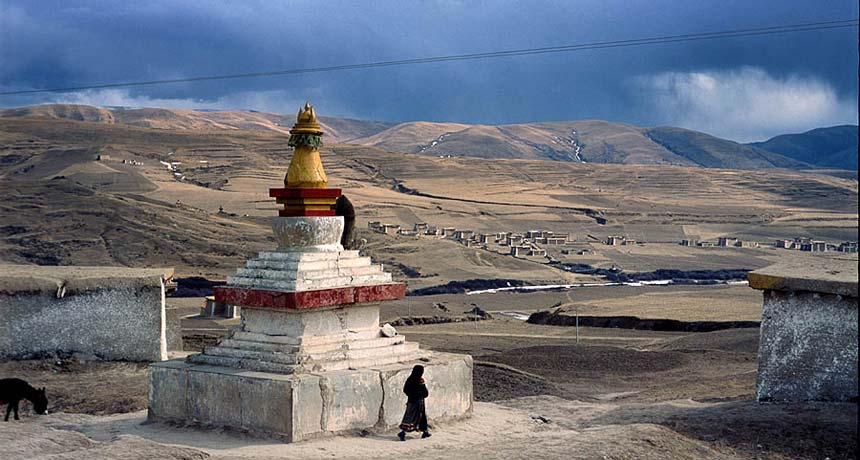High-altitude help from extinct ancestors
Gene mutation passed on from long-extinct Neandertal ‘cousins’ seems to help modern Tibetans survive at high altitudes

The Tibetan plateau is high, cold and oxygen-poor. Tibetans survive there thanks in part to the unusual version of one gene they carry. They inherited it from long-extinct ancestors known as Denisovans.
JIALIANG GAO, WWW.PEACE-ON-EARTH.ORG/WIKIMEDIA COMMONS (CC BY-SA 3.0)
Tibet has been called the “roof of the world.” It’s a vast region in southwest China that sits on the highest plateau on Earth. It’s cold and dry. What’s more, its air has 40 percent less oxygen than does the air at sea level. That should make it difficult for people to live there. But Tibetans comfortably survive such extreme conditions. And it’s due in part to an ancient genetic gift from their ancestors. These were amazingly ancient ancestors, a new study finds. Those long-extinct folk were essentially cousins of Neandertals.
Scientists have known that Tibetans carry an unusual form of a gene called EPAS1. A gene is a snippet of DNA, found inside cells. It tells a cell how to make the molecules that will help it function. The EPAS1 gene helps the body use oxygen. The version of this gene in the native people of Tibet helps them deal with their homeland’s extremely low levels of oxygen.
Researchers had wondered when that altered gene first evolved. Its small but important genetic tweak almost certainly came from an ancient group of pre-human relatives, scientists now report. They share their analyses in the July 2 Science.
Anna Di Rienzo, who studies genes at the University of Chicago, did not work on the new study. She says the new findings provide evidence that humans picked up genetic changes from other ancient species. The gene may have been passed along when two closely related species produced offspring together, she told Science News. Such breeding across closely related species likely introduced other helpful genetic changes as well, she adds.
Rasmus Nielsen led the new study. Earlier, this geneticist at the University of California, Berkeley, had looked for the source of the Tibetan gene variant in other peoples. In one study, he showed it probably did not come from the Han Chinese. They are closely related to Tibetans. In another study, he probed the DNA of ancient Neandertals. Again, no match.
“So we just put it aside because we couldn’t make sense of the data,” Nielsen told Science News.
But in 2010, researchers discovered a finger bone from a previously unknown ancient group of pre-human folk. Scientists named these hominids Denisovans (Deh-NEE-so-vuns). In 2012, researchers finished describing the entire Denisovan genome (all of an individual’s DNA). To their surprise, when Nielsen and his team looked at this genome, they now found a match. The Denisovans had the same EPAS1 change that helps Tibetans survive in low-oxygen environments.
The discovery indicates that the Tibetans probably inherited the genetic tweak from those Denisovans.
Pontus Skoglund is not entirely convinced, however, that the genetic journey from Denisovans to modern humans is as straightforward as it might at first seem. Skoglund is a geneticist at Harvard Medical School in Boston, Mass. Denisovans interbred with that other ancient group, the Neandertals, he notes. And scientists have found evidence that ancient humans interbred with Neandertals. Modern people, including Tibetans, still have some DNA inherited from Neandertals. So, Skoglund told Science News, “there’s still a little wiggle room for [the EPAS1 variant] to have come from Neandertals.”
Power Words
archaic An adjective meaning ancient. Something from a far earlier period in time, often thousands, if not millions, of years ago.
Denisovans An ancient humanlike population whose existence is known only because of a few fossils discovered in a cave in Siberia.
DNA (short for deoxyribonucleic acid)A long, spiral-shaped molecule inside most living cells that carries genetic instructions. In all living things, from plants and animals to microbes, these instructions tell cells which molecules to make.
evolution A process by which species undergo changes over time, usually through genetic variation and natural selection. These changes usually result in a new type of organism better suited for its environment than the earlier type. The newer type is not necessarily more “advanced,” just better adapted to the conditions in which it developed.
gene A segment of DNA that codes, or holds instructions, for producing a protein. Offspring inherit genes from their parents. Genes influence how an organism looks and behaves.
genetic Having to do with chromosomes, DNA and the genes contained within DNA. The field of science dealing with these biological instructions is known as genetics.
hominid A primate of an animal family that includes humans and their fossil ancestors.
Neandertal (sometimes spelled Neanderthal) A species (Homo neanderthalensis) that lived in Europe and parts of Asia from about 200,000 years ago to roughly 28,000 years ago.
oxygen A gas that makes up about 21 percent of the atmosphere. All animals and many microorganisms need oxygen to fuel their metabolism.
variant (in genetics) A gene having a slight mutation that may have left its host species somewhat better adapted for its environment.







